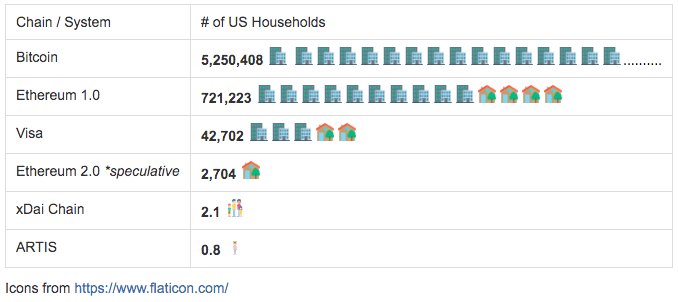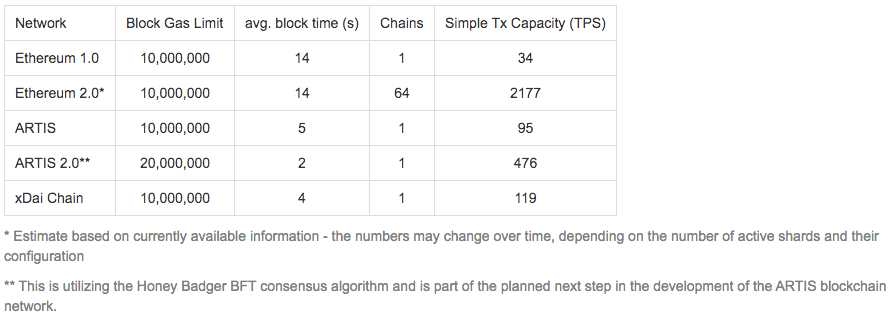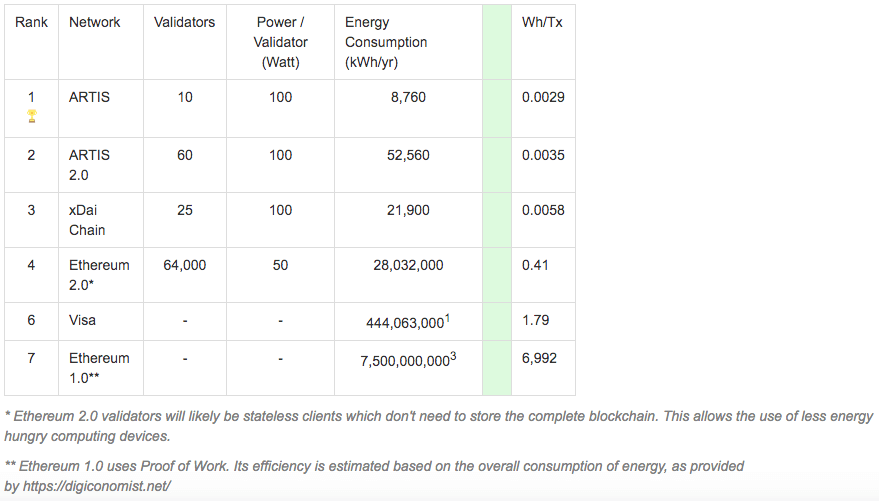ARTIS’s Energy Efficiency
June 11, 2020
3 min. read
In this article we want to present the details about the calculation for energy efficiency of blockchain systems, which is of vital importance when thinking of sustainability.
We strive at world class efficiency for the ARTIS blockchain in combination with very short block times and high throughput. Our friends from POA Network have written about the energy efficiency of the xDai Chain, which you can find here.
Energy Usage Overview
Energy usage equivalents (number of average US households consume the same amount of energy as the following chains / Visa).

Energy Efficiency Comparison
The Visa payment network is often used to compare the blockchain systems with traditional systems. Instead of only looking at the possible transactions throughput, we also had a look at their energy consumption and worked out a way to normalize the number of transactions in every blockchain network.

Note that this figure includes only the energy in the form of electricity – mostly data centers2 around the globe.
It does NOT include other forms of energy consumption, e.g. heating of office buildings, work related traveling of employees etc. It also doesn’t account for energy consumed by the banking infrastructure Visa depends on.
Transaction Capacity Normalization
Transactions in application-specific Blockchain networks like Bitcoin are quite uniform in terms of size/complexity/cost. That makes the comparison with a conventional system like Visa straightforward.
In smart contract capable blockchain networks like Ethereum or ARTIS, the size/complexity/cost of transactions can vary greatly, up to more than 2 orders of magnitude. For this comparison, we thus use “normalized” transactions.
The Ethereum protocol specifies a fee of 21,000 “gas” for simple transfers of native tokens (e.g. ETH in Ethereum, ATS in ARTIS). This results in the following numbers for max. transaction capacities:

Keep in mind that TPS figures alone never give the full picture, because there’s usually a tradeoff between max. throughput and decentralization/security.
Energy Efficiency Ranking
First we want to look at current and future networks and compare their energy consumption per transaction (capacity).

As expected, a lower number of validators has a positive effect on the energy efficiency and also on the performance (in terms of TPS) of the network.
There is an ongoing discussion about how many full copies of a blockchain are needed for sufficient decentralization and resilience. In our opinion this can’t be easily answered and therefore we want to refer to the Blockchain Trilemma4, coined by Vitalik Buterin (founder of Ethereum), which describes the difficulty of reconciling decentralization, security and scalability as a starting point of further discussions.
Wh/Tx isn’t a very intuitive metric, thus we thought about a suitable analogy for the needed energy per transaction and settled with the energy radiated as heat by an adult human, which is about 100 Watt.
Using energy usage equivalents per transaction with this metric (in seconds of a human’s heat radiation), the comparison looks like this:

The number for Ethereum already looks outrageous.
However… this is the number for Bitcoin: about 5000h / 7 months.
Conclusion
The ARTIS network is a highly energy efficient and performant blockchain system and will further improve with the upgrade to the Honey Badger BFT consensus.
References
1 Visa, CSR Report 2018: https://usa.visa.com/dam/VCOM/download/corporate-responsibility/visa-2018-corporate-responsibility-report.pdf
2 Visa, Fiscal Report 2019: https://s24.q4cdn.com/307498497/files/doc_downloads/Visa_Inc_Fiscal_2019_Annual_Report.pdf
3 Ethereum Energy Consumption: https://digiconomist.net/ethereum-energy-consumption
4 Blockchain Trilemma, Vitalik Buterin: https://github.com/ethereum/wiki/wiki/Sharding-FAQ#this-sounds-like-theres-some-kind-of-scalability-trilemma-at-play-what-is-this-trilemma-and-can-we-break-through-it